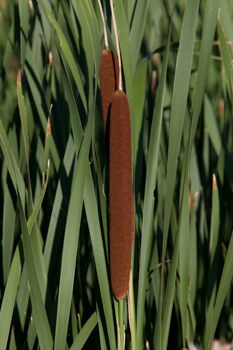
NPS Rivers, Lakes, and Wetlands Home IntroductionThese familiar plants grow on mud flats or in shallow water, often in extensive stands. They have an important ecological impact because of their sheer numbers, prodigious reproductive capacity, and enormous biomass production. Cattails reproduce by both seed (an average of 220,000 seeds in a single brown, sausage-like seedhead) and vegetatively through clones emerging from a single rhizome. A single rhizome may produce up to 100 stalks in a 10' diameter circle in a single growing season. The leaf blades are up to six to seven feet in length. There are two cattail species in our area. The broad-leafed cattail (Typha latifolia) has leaves about an inch wide and the seed spike extends above the leaf blades. The pistillate and staminate parts of the seed spike are adjacent to each other. The narrow-leafed cattail (Typha angustifolia) is a less robust plant with leaf blades taller than the seed spike and with the staminate and pistillate parts of the seed spike clearly separated. To complicate identification, these two species may hybridize. Cattails provide valuable food resources for wildlife. Muskrats and geese feed on the starchy rhizomes and muskrats use the leaves and seed spikes to build their lodges and feeding platforms. Many wetland birds, such as red-winged blackbirds and marsh wrens, build their nests in dense cattail stands. Many insects live in and near stands of cattail and some species of fish may spawn among cattails. Fascinating Facts
Find ItCattails are found in many areas of the Mississippi National River and Recreation Area, especially in marshes and around ponds. Search shallow water areas of Crosby Farm Park and the Pickerel Lake area in Lilydale Regional Park. Want to Help Us Better Understand the Park?See our iNaturalist project, "The Life of the Mississippi National River and Recreation Area" and contribute to it by downloading the iNaturalist app and uploading your sightings of this species, and others, to the project. You can also upload your sightings from your computer. |
Last updated: March 21, 2018
